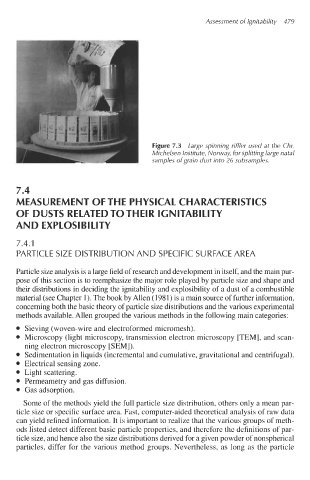Page 512 - Dust Explosions in the Process Industries
P. 512
Assessment of lgnitability 479
Figure 7.3 Large spinning riffler used at the Chr.
I
Michelsen Institute, Norway, for splitting large natal
samples of grain dust into 26 subsamples.
7.4
MEASUREMENT OF THE PHYSICAL CHARACTERISTICS
OF DUSTS RELATED TO THEIR ICNlTABlLlTY
AND EXPLOSI BI LlTY
7.4.1
PARTICLE SIZE DISTRIBUTION AND SPECIFIC SURFACE AREA
Particle size analysis is a large field of research and development in itself, and the main pur-
pose of this section is to reemphasize the major role played by particle size and shape and
their distributions in deciding the ignitability and explosibility of a dust of a combustible
material (see Chapter 1). The book by Allen (1981) is a main source of further information,
concerning both the basic theory of particle size distributions and the various experimental
methods available. Allen grouped the various methods in the following main categories:
Sieving (woven-wire and electroformed micromesh).
Microscopy (light microscopy, transmission electron microscopy [TEM], and scan-
ning electron microscopy [SEMI).
Sedimentation in liquids (incremental and cumulative, gravitational and centrifugal).
Electrical sensing zone.
Light scattering.
Permeametry and gas diffusion.
Gas adsorption.
Some of the methods yield the full particle size distribution, others only a mean par-
ticle size or specific surface area. Fast, computer-aided theoretical analysis of raw data
can yield refined information. It is important to realize that the various groups of meth-
ods listed detect different basic particle properties, and therefore the definitions of par-
ticle size, and hence also the size distributions derived for a given powder of nonspherical
particles, differ for the various method groups. Nevertheless, as long as the particle

